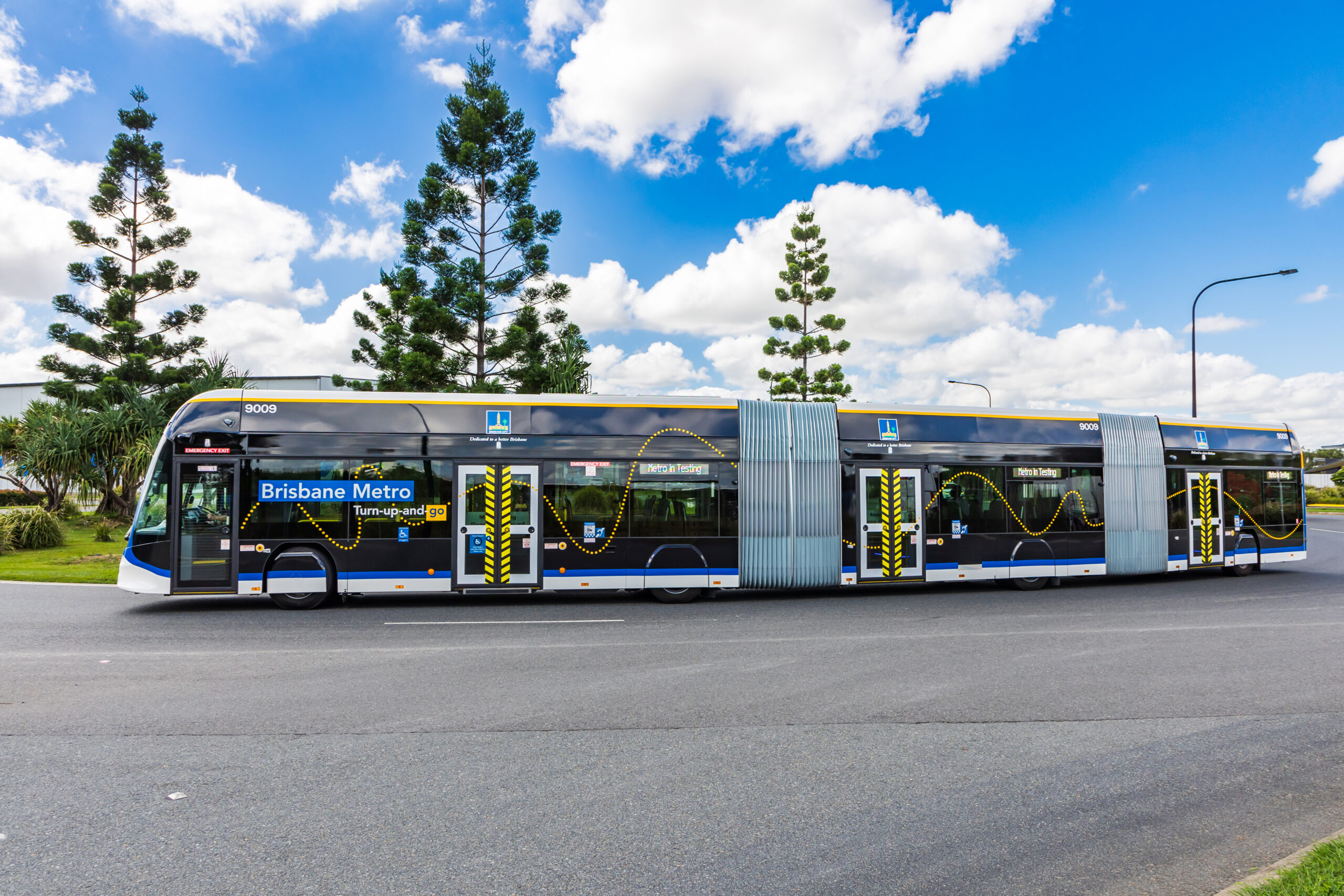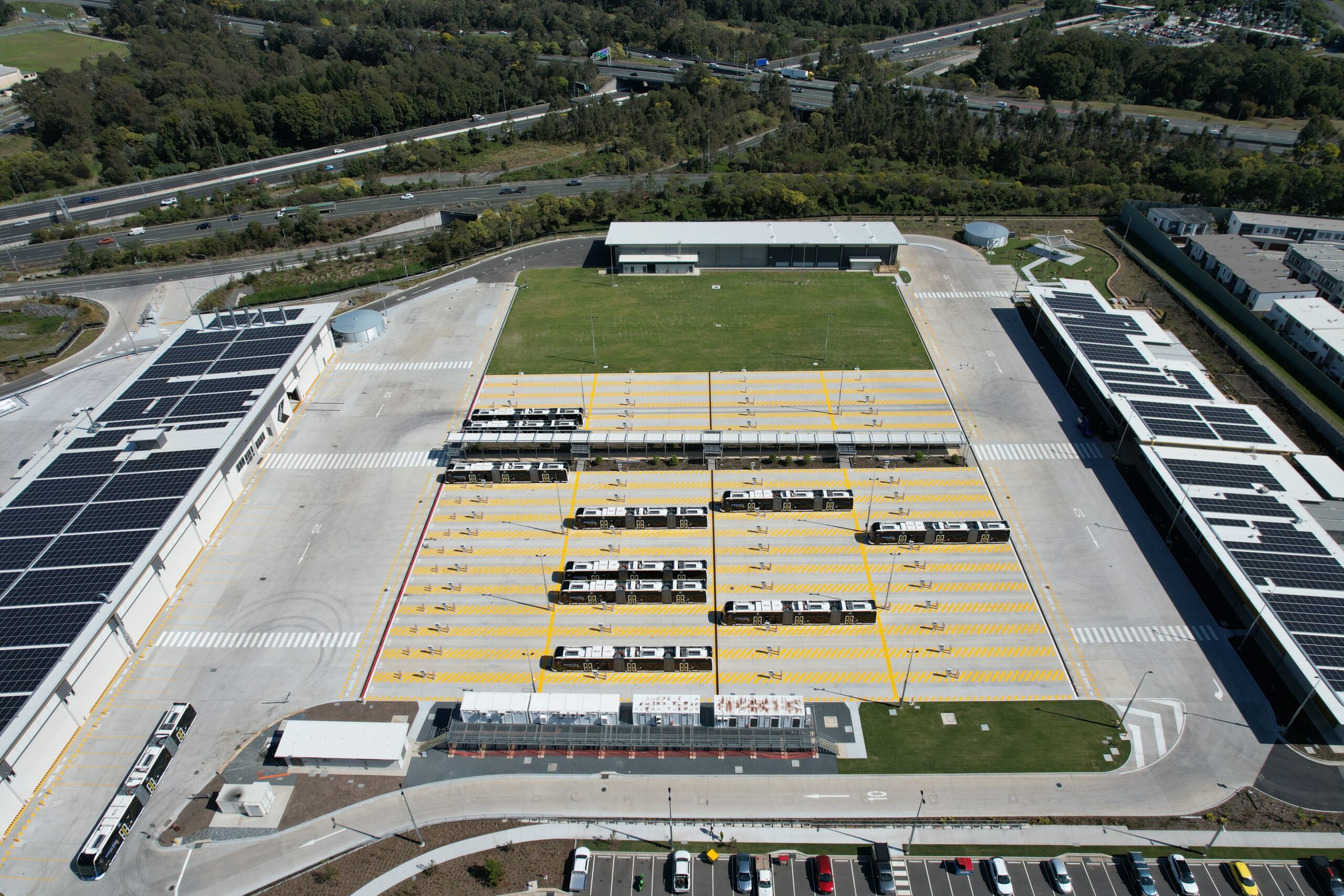Join every day information updates from CleanTechnica on e mail. Or comply with us on Google Information!
Like many fashionable cities, Brisbane was serviced by an environment friendly electrical tram community till the ’70s, when it was ripped up and diesel buses took the place of trams. We’ve all seen Who Framed Roger Rabbit?, and so we all know who was actually behind that transfer. In a retro revolution, Brisbane is about to usher in an electrical Metro system, with electrical “Metro” buses for clear mass transit. Ought to have left the trams in, say many.
This transfer has its sights set on a clear, inexperienced Olympic video games in 2032, in addition to lowering air pollution within the riverside metropolis. You possibly can watch the video of the futuristic autos designed by HESS, manufactured by Volgren, and powered by Hitachi right here.
Now, 59 HESS lighTram® 25 autos have been ordered and are anticipated to be in service throughout the month. In response to the council, “Metros embody the high-quality and high-capacity options of sunshine rail whereas avoiding the necessity for tracks, overhead line gear and infrastructure by utilising our present busway. With a spacious bi-articulated design, metros comfortably transport 150 passengers and 170 passengers in occasion mode, enabling larger capability on Brisbane’s public transport community.”

“Via a novel co-design course of with the accessibility sector Brisbane Metro is aiming to exceed compliance with related incapacity requirements and pointers to assist ship Australia’s main accessible public transport choice. Key achievements embody growing the quantity and dimension of mobility assist bays and the variety of precedence seating areas, making this Australia’s main accessible public transport choice.”
The council has spent the 18 months testing the autos. This weekend, they’ll host an open day on the south aspect of town, inviting the general public to “Discover considered one of Australia’s most technologically superior depots.” The depot can also be sustainable, utilizing photo voltaic, recycled gray water, and rainwater assortment.

“Greater than 2,300 photo voltaic panels have been put in, producing clear power equal to the annual energy consumption of 280 houses. This initiative alone is anticipated to scale back carbon emissions by an quantity corresponding to eradicating over 500 vehicles from Brisbane’s roads every year. The Brisbane Metro Depot has been awarded a 5 Star Inexperienced Score for its sustainable design. The location incorporates rainwater harvesting and recycled water methods for automobile washing, additional contributing to its environmental credentials.”

How do you cost a fleet that huge and that energy hungry with out crashing the native electrical energy grid? Brisbane Metro has chosen to make use of two forms of charging: flash charging (Grid eMotion™) and CCS2 plug-in gradual chargers. That is the primary time that Grid-eMotion flash charging has been utilized in Australia. It may possibly cost a metro in beneath six minutes and shall be delivered utilizing overhead pantograph infrastructure. You noticed that within the video above. The pantograph will autonomously connect with the charging level within the metro roof. The council plans to put in 15 “Flash” chargers with 600 kW of capability every at end-of-route places.
60 x 50 kW gradual chargers can be found on the on the Southside metro depot for off-peak charging — optimising Queensland’s power grid and in addition growing battery lifespan.
“A Energy Load Administration system controls the gradual charging on the metro depot and optimises the present draw from the grid to reasonable peak masses.”
Brisbane Metropolis Council has made intensive modifications in the course of the trial after consultations with the “accessibility sector” to make it possible for the Brisbane Metro is considered one of Australia’s main accessible types of transport. The Metros will provide onboard USB charging and free WiFi.
Hitachi’s Grid–eMotion® Flash charging answer was beforehand referred to as TOSA. By using ultra-fast charging at intermediate stops, it optimizes operational price and comfort for fleets. Hitachi claims that “the system can save as a lot as 1,000 tons of CO2 on a bus line overlaying roughly 600,000 kilometres per 12 months. As well as, the e-bus’ power prices are 30 % under these of a diesel bus.” Extremely-fast charging eliminates the necessity for catenaries and reduces the scale of required batteries. Vary and schedule limitations are now not an issue.
Grid-eMotion® Flash has already confirmed itself in Nantes, France, enabling the native operator Semitan to transition to sustainable mobility. Grid-eMotion Flash permits Semitan to flash-charge its e-buses inside seconds at passenger stops. The decreased dimension of the batteries required will increase passenger capability. “Due to this answer, passengers now get pleasure from a cleaner, quieter and smoother journey.”
HESS’ CEO, Alex Naef, mentioned of the Brisbane Metro challenge: “The lighTram® 25 gives one thing distinctive within the Australian transport sector: a automobile able to quietly, effectively and sustainably transporting giant numbers of individuals, all whereas offering an elevated passenger expertise.” He believes that the mixture of the lighTram 25 and flash charging “is a sexy answer for public transport methods not simply in Europe, however across the globe.”
“This can be a versatile transport system that isn’t reliant on rail infrastructure and might simply be tailored for various transport routes due to the automobile’s manoeuvrability. Over the total lifetime of the automobile, the lighTram® 25 gives cities one of the vital cost-effective options for bettering public transport and reaching governments’ sustainability targets,” Naef mentioned.
He elaborated on the analysis of the trial program, which included: busway efficiency, manoeuvrability, pace, acceleration, braking, power consumption, recharging, passenger accessibility, and the general driver expertise.
“Brisbane Metropolis Council, HESS and key stakeholders spent appreciable time growing what is about to grow to be one of the vital accessible public transport choices in Australia. The metro has been uniquely co-designed with three giant and simply accessible mobility assist bays within the first compartment, an automated electrical ramp, listening to loops and the power to speak with the motive force through automobile assist factors, amongst different options,” Naef defined.
“Driver suggestions has additionally been very constructive with driving stability and automobile manoeuvrability two key themes which can be rated extremely by drivers.”
“Our philosophy is that HESS autos are there before everything to hold passengers, not batteries,” Alex mentioned.
Hess confirms that different Australian transport operators and authorities are displaying curiosity on this new transport answer. Hopefully it gained’t be lengthy earlier than they’ll get on board each figuratively and actually. Australia may use an efficient answer to heavy street transport as properly. Might this identical system be used for semis carrying items throughout our extensive brown land?
It’s getting up entrance and private with plans to increase the metro community to the north aspect of town and into the suburb the place I reside in Bracken Ridge. Appears to be like like we may be getting a depot and charging station close by at Fitzgibbon. The longer term is intruding on the current and the rEVolution is gathering tempo.
Will Brisbane Metro imply fewer folks in vehicles and fewer congestion? Metros will use the present busway community. It ought to actually imply fewer diesel and LPG powered buses on the street — at the moment round 1200. Solely time will inform, however actually the way forward for public transport in Brisbane is vibrant, accessible, and electrical. Come go to for the Olympics and check out it for your self!

Have a tip for CleanTechnica? Wish to promote? Wish to recommend a visitor for our CleanTech Speak podcast? Contact us right here.
Newest CleanTechnica.TV Movies

CleanTechnica makes use of affiliate hyperlinks. See our coverage right here.
CleanTechnica’s Remark Coverage
